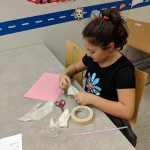This fall our informal learning space, the BOOMbox, is exploring all things music. The rotation is 16 weeks long and we’re focusing on a different concept related to music about every two weeks. This month’s STEAM program for youth grades 3-5 aligned with the rotation and we explored the physics of sound in a hands on way by making membranophones, courtesy of the Exploratorium in San Francisco. Here’s what we did.
Like previous Be the Scientist programs featured on the blog, the program began with an overview using a short slide presentation. This allows us to set the stage for the program and welcome participants’ prior knowledge before we begin the hands on component. The slide presentation defined sound and how we hear and make it, using more scientific phrases and terminology that was new to some of the participants. We then transitioned into the program’s challenge: making sound via a membranophone.
We first discussed real life examples of membranophones like drums and gongs and how they made sound before watching a short video from the Exploratorium’s experiment overview. Please note we asked participants if they wanted to see the video before or after making their own membranophone and they opted to watch it before. We also had an example membranophone that staff made, which is not always included in these types of programs but served well in this context.
Then we shared specifics of the challenge, that participants were to use provided supplies to make their own membranophone with the goal of it making a sound. We asked them to consider which variable they would explore, either material of the glove (latex or vinyl) and the length of the paper tube, and to share their observations after completing the challenge.
All participants opted to not use the directions sheet from the Exploratorium and went into full experimentation mode. They had trouble securing the plastic gloves to the bottle, as the bottle was very thin and bent easily. But everyone was able to make their own version of a membranophone that produced sound.
We really liked this activity because it’s visually helpful in describing how sound is produced and kids like the sound since it reminds them of something more biological, if you catch our drift. We also appreciated the clear instructions from the Exploratorium and how inexpensive this project was to implement.
We encourage you to checkout more Science Snacks activities from the museum and test them out with your community of scientists.





Leave A Comment